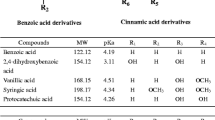Abstract
A novel low-pressure preparative electrochromatography apparatus was set up to implement the separation of small polar compounds. In this apparatus, a distinguished bottom “T”-shape electrode chamber was designed to remove electrolysis gas and meanwhile enable the apparatus to separate small-molecule solutes. Partial separation of the model sample, crude tea extract (mainly containing (−)-epigallocatechin gallate, (−)-epicatechin gallate and caffeine) by hydrophobic macroporous adsorption column (maximum 40 cm × 20 mm ID) with electric field (maximum 111.0 V cm−1) proved the effectiveness of the electrochromatography apparatus. The fact that the total solute recoveries were over 90% showed the qualification of the apparatus for preparative purpose. The stronger the electric field, the more obvious the electrically induced effects. An alternative in-liquid load manner (loading sample in liquid after the electric field was applied) was proposed, which could further enhance the electrically induced effects than in-column load manner (loading sample on resin bed before applying electric field). Scale-up on electrochromatography by column diameter from 6 to 20 mm resulted in similar electrically induced effects on peak resolutions. All of these investigations revealed that the new technology was feasible and promising on separating small polar compounds, for it inherits the advantages of both liquid chromatography and electrophoresis.




Similar content being viewed by others
References
Ivory CF (1988) Sep Sci Technol 23:875–912. doi:10.1080/01496398808063143
Rudge SR, Basak SK, Ladisch MR (1993) AIChE J 39:797–808. doi:10.1002/aic.690390508
Basak SK, Velayudhan A, Kohimann K, Ladisch MR (1995) J Chromatogr A 707:69–76. doi:10.1016/0021-9673(94)01276-K
Keim C, Ladisch M (2000) Biotechnol Bioeng 70:72–81. doi:10.1002/1097-0290(20001005)70:1<72::AID-BIT9>3.0.CO;2-F
Cole KD, Cabezas H (1997) J Chromatogr A 760:259–263. doi:10.1016/S0021-9673(96)00774-1
Tellez CM, Cole KD (2000) Electrophoresis 21:1001–1009. doi:10.1002/(SICI)1522-2683(20000301)21:5<1001::AID-ELPS1001>3.0.CO;2-3
Cole KD (1997) Biotechnol Prog 13:289–295. doi:10.1021/bp970025a
Cole KD, Tellez CM, Blakesley RW (2000) Electrophoresis 21:1010–1017. doi:10.1002/(SICI)1522-2683(20000301)21:5<1010::AID-ELPS1010>3.0.CO;2-7
Park YG (2001) Biochem Eng J 7:213–221. doi:10.1016/S1369-703X(00)00125-X
Strege MA (1998) Anal Chem 70:2439–2445. doi:10.1021/ac9802271
Schlichtherle-Cerny H, Affolter M, Cerny C (2003) Anal Chem 75:2349–2354. doi:10.1021/ac026313p
Zhang H, Guo Z, Zhang F, Xu Q, Liang X (2008) J Sep Sci 31:1623–1627. doi:10.1002/jssc200700656
Peru KM, Kuchta SL, Headley JV, Cessna AJ (2006) J Chromatogr A 1107:152–158. doi:10.1016/j.chroma.2005.12.057
Ali MS, Rafiuddin S, Ghori M, Khatri AR (2008) Chromatographia 67:517–527. doi:10.1365/s10337-008-0542-5
Appelblad P, Jonsson T, Jiang W, Irgum K (2008) J Sep Sci 31:1529–1536. doi:10.1002/jssc.200800080
Ikegami T, Tomomatsu K, Takubo H, Horie K, Tanaka N (2008) J Chromatogr A 1184:474–503. doi:10.1016/j.chroma.2008.01.075
Suo Y, Wang H, Li Y, You J, Wang H (2004) Chromatographia 60:589–595. doi:10.1365/s10337-004-0415-5
Xiong B, Zhang L, Zhang Y, Zou H, Wang J (2000) J High Resolut Chromatogr 23:67–72
Karenga S, Rassi ZE (2008) J Sep Sci 31:2677–2685. doi:10.1002/jssc.200800310
Wang R, Zhou W, Jiang X (2008) J Agric Food Chem 56:2694–2701. doi:10.1021/jf0730338
Zheng X, Chen A, Hoshi T, Anzai J, Li G (2006) Anal Bioanal Chem 386:1913–1919. doi:10.1007/s00216-006-0752-3
Kumamoto M, Sonda T, Nagayama K, Tabat M (2001) Biosci Biotechnol Biochem 65:126–132. doi:10.1271/bbb.65.126
Carregaro AB, Mataqueiro MI, Soares OAB, Queiroz-Neto A (2004) J Appl Toxicol 24:513–518. doi:10.1002/jat.1011
Horie H, Mukai T, Kohata K (1997) J Chromatogr A 758:332–335. doi:10.1016/S0021-9673(96)00764-9
Vallano PT, Remcho VT (2001) J Phys Chem B 105:3223–3228. doi:10.1021/jp003525m
Rifai RA, Demesmay C, Crétier G, Rocca JL (2001) Chromatographia 53:691–696. doi:10.1007/BF02493022
Kučerová Z, Szumski M, Buszewski B, Jandera P (2007) J Sep Sci 30:3018–3026. doi:10.1002/jssc.200700346
Bellaistre MC, Randon J, Rocca J (2006) Electrophoresis 27:736–741. doi:10.1002/elps.200500341
Nischang I, Tallarek U (2004) Electrophoresis 25:2935–2945. doi:10.1002/elps.200405990
Rathore AS (2002) Electrophoresis 23:3827–3846. doi:10.1002/elps.200290004
Acknowledgment
Our work was supported by Shanghai Leading Academic Discipline Project of China (B203) and Shanghai Nanometer Project of China (0259nm015).
Author information
Authors and Affiliations
Corresponding author
Rights and permissions
About this article
Cite this article
Feng, L., Zhao, F. Preparative Electrochromatography of Tea Polyphenols and Caffeine. Chroma 69, 1325–1332 (2009). https://doi.org/10.1365/s10337-009-1021-3
Received:
Revised:
Accepted:
Published:
Issue Date:
DOI: https://doi.org/10.1365/s10337-009-1021-3




